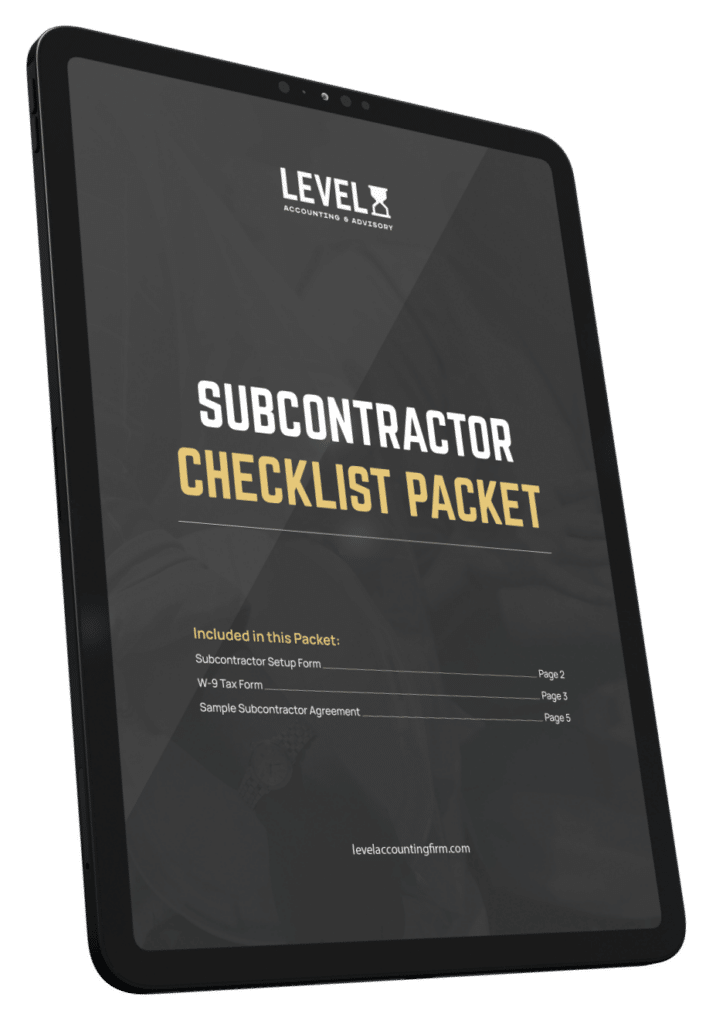Running a successful construction business requires more than quality craftsmanship and reliable crews. Many contractors wonder what monthly financial reports do contractors need to truly understand their business performance. The answer is critical—because with tight schedules and constant project demands, too many contractors only look at their numbers when there’s a cash flow problem or tax season arrives.
At Level Accounting & Advisory, we’ve seen how understanding what monthly financial reports contractors need and reviewing them regularly transforms construction businesses from constantly putting out fires to proactively growing and increasing profits. Here’s our comprehensive guide to the monthly financial reports every contractor should have and review.
Why Monthly Financial Reports Matter for Contractors
Before diving into specific reports, let’s talk about why monthly review matters in construction:
- Project-based revenue: Unlike many businesses with steady income, contractors experience significant revenue fluctuations based on project timing
- High overhead costs: Equipment, insurance, and staffing create substantial fixed expenses that require careful monitoring
- Thin profit margins: The industry average profit margin for construction is 3-5%, leaving little room for financial mistakes
- Cash flow challenges: The gap between expenses and payment collection can quickly create cash shortages
One framing contractor we work with went from near-bankruptcy to 12% profit margins simply by implementing monthly financial reviews. Let’s look at the reports that made this possible.
The 7 Monthly Financial Reports Contractors Need to Review
1. Job Cost Reports
What it shows: Actual costs versus estimated costs for each project, broken down by labor, materials, subcontractors, and other direct expenses.
Why it’s crucial: Without job costing, you can’t tell which projects are profitable. One electrical contractor discovered they were consistently losing money on commercial lighting projects—a problem they fixed by adjusting their bidding process.
Software that will help: JobTread. JobTread provides construction businesses with powerful job costing software that tracks real-time costs against estimates for every project. Their intuitive platform generates comprehensive job costing reports that help contractors identify profitability issues, manage labor efficiency, and make data-driven decisions to improve margins.
Key metrics to watch:
- Labor cost variance (estimated vs. actual)
- Material cost variance
- Project completion percentage vs. percentage of budget used
2. Work-in-Progress (WIP) Report
What it shows: For each ongoing project, it tracks contract amount, estimated costs, costs to date, billings to date, and projected profit.
Why it’s crucial: The WIP report helps identify underbillings or overbillings and shows if projects are on track financially. A plumbing contractor we advise used their WIP report to identify a $42,000 underbilling situation they were able to correct before it created cash flow problems.
Key metrics to watch:
- Over/under billing by project
- Projected gross profit
- Cost to complete
3. Cash Flow Forecast
What it shows: Projected cash inflows and outflows for the next 8-12 weeks.
Why it’s crucial: Construction businesses often fail due to cash flow issues, not profitability problems. One roofing company we work with uses their cash flow forecast to time material purchases and determine when they can safely take on new projects.
Key metrics to watch:
- Weekly cash position
- Payment timing for major invoices
- Upcoming large expenses (equipment payments, insurance premiums)
4. Accounts Receivable Aging
What it shows: Outstanding customer invoices categorized by age (current, 1-30 days, 31-60 days, etc.).
Why it’s crucial: Slow-paying customers directly impact your ability to meet payroll and other obligations. A drywall contractor implemented a new collections process after seeing their average collection period stretch to 47 days, bringing it down to 32 days.
Key metrics to watch:
- Average collection period
- Percentage of receivables over 60 days
- Collection effectiveness ratio
5. Profit and Loss Statement (P&L)
What it shows: Your revenue, expenses, and profit for the month, quarter, and year-to-date.
Why it’s crucial: The P&L reveals trends in your business’s profitability and highlights expense categories that may be getting out of control. A flooring contractor noticed their vehicle expenses had increased 32% while revenue remained flat—they discovered unnecessary trips between job sites that were easily eliminated.
Key metrics to watch:
- Gross profit margin (aim for 20-30%)
- Overhead percentage (typically 10-15% in construction)
- Net profit margin (industry average is 3-5%)
6. Balance Sheet
What it shows: Your assets, liabilities, and equity at a specific point in time.
Why it’s crucial: The balance sheet reveals your company’s financial health and borrowing capacity. An HVAC contractor we advise uses their monthly balance sheet to monitor their debt-to-equity ratio, ensuring they maintain the borrowing capacity needed for growth.
Key metrics to watch:
- Current ratio (assets divided by liabilities, aim for 1.5 or higher)
- Debt-to-equity ratio
- Working capital
7. Equipment Utilization Reports
What it shows: Usage hours and costs associated with major equipment.
Why it’s crucial: Underutilized equipment drains resources through maintenance, insurance, and depreciation costs. A concrete contractor discovered they were only using a $125,000 specialized mixer 2-3 days per month—they sold it and now rent when needed, saving $1,800 monthly.
Key metrics to watch:
- Utilization rate (days used vs. days available)
- Maintenance costs per operating hour
- Revenue generated per equipment dollar
How to Implement Monthly Financial Reports for Your Construction Business
Many contractors know they should review financial reports but struggle to make it happen. Here’s a practical implementation approach:
- Schedule a specific monthly review date
Block 2 hours on your calendar 10 days after month-end. - Use construction-specific accounting software
QuickBooks for Contractors, Foundation, or Jonas Construction Software make report generation easier. - Start with the three most critical reports
Begin with Job Cost, WIP, and Cash Flow Forecast. - Create a one-page summary
Identify 5-7 key metrics across your reports to track monthly. - Take one specific action each month
Make one improvement based on what the numbers tell you.
Case Study: Monthly Reports Save a Concrete Contractor $98,000
A concrete contractor with $3.2 million in annual revenue implemented monthly financial reviews with our guidance. After just three months of regular reviews, they:
- Identified two consistently unprofitable service lines they were able to adjust pricing on ($42,000 annual improvement)
- Discovered significant material waste at specific job sites ($27,000 annual savings)
- Recognized and corrected underbilling issues ($18,000 one-time recovery)
- Implemented equipment utilization tracking and sold underused assets ($11,000 annual savings)
Total financial impact: $98,000 in one year from just a 2-hour monthly commitment.
How Level Accounting & Advisory Can Help
Getting accurate, timely financial reports requires proper bookkeeping and accounting systems. At Level Accounting & Advisory, we help contractors:
- Set up construction-specific accounting systems
- Generate and interpret monthly financial reports
- Identify key performance indicators unique to your business
- Create actionable insights from financial data
- Build forecasting models for better decision-making
Our construction clients often tell us the monthly financial review meeting is the most valuable two hours they spend each month.
Ready to gain clarity and control over your construction business finances? Contact Level Accounting & Advisory today to set up your monthly financial reporting system.


